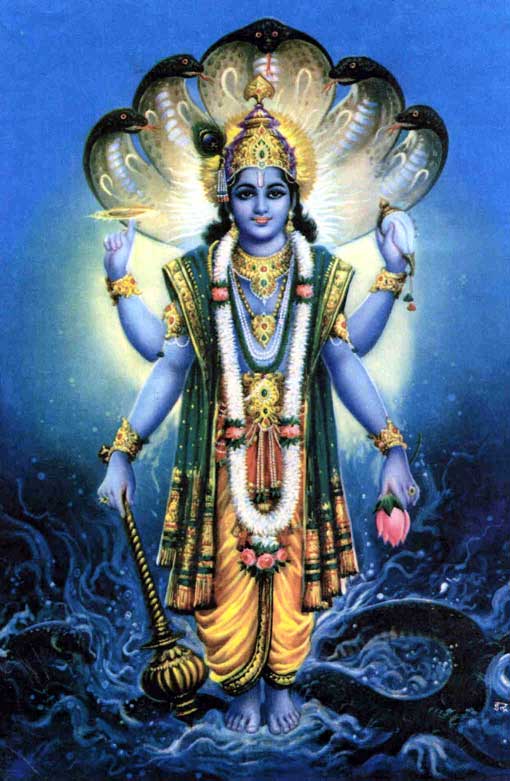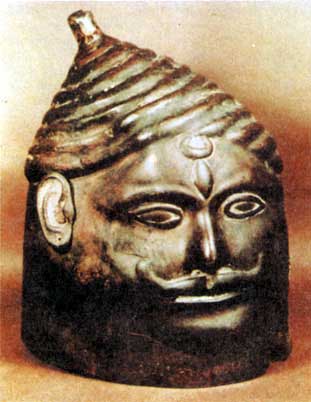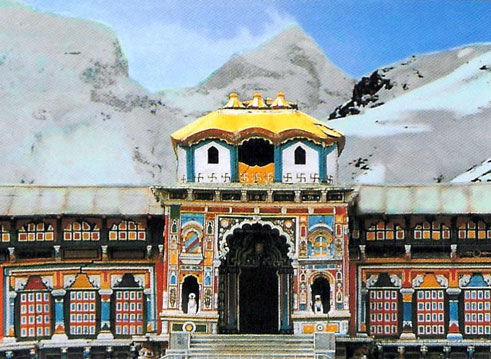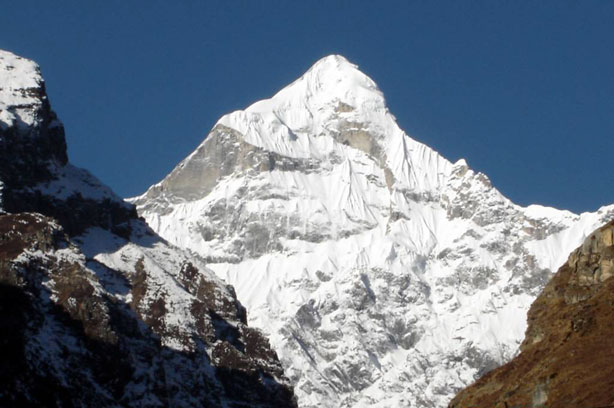Legend has it, when the Ganga was requested to descend to earth to help suffering humanity, the earth was unable to withstand the force of its descent. Therefore the mighty Ganaga was split into twelve holy channels. Alaknanda was one of them that later became the abode of Lord Vishnu or Badrinath.
The temple of Shri Badrinathji on the banks of the Alaknanda river, dates back to the vedic times. Situated at an altitude of 3,133 mts., the present temple is believed to have been built by Adi Guru Shankaracharya- an 8th century's philosopher-saint, who also established a 'math' here. Also known as 'Vishal Badri', Badrinath is one of the Panch Badris.

Lord Narayana
Badrikashrama
The four main dhams or holy shrines in the Himalayas are Badrinath, the abode of Lord Narayana, Kedarnath, the abode of Lord Shiva, Gangotri, the source of the river Ganga and Yamunotri, the source of the river, Yamuna. Of these Badrinath is considered to be the most sacred. In the Bhagavad Purana, Lord Krishna tells his friend and devotee, Uddhava that in future he would be available only in the holy spot of Badrikashrama (Badrinath). He gave Uddhava his sandals and told him to carry them to Badrinath and keep it there for people to worship. These are to be seen even now. The Hindu scriptures say that the life of a Hindu would be incomplete without making a visit to Badrinath. It is the supreme place of pilgrimage especially for the Vaishnavites (worshippers of Vishnu and his avataras). According to the Padma Purana, the rishis found Uttrakhand (modern Uttranchal) to be indeed a glorious temple built by Nature for the worship of the Supreme.
From time immemorial the whole of India has been linked with these holy spots by a bond of consecrated faith.
Badrinath has a very ancient history. It dates from the Vedic period. It is a common belief that many of the Vedic hymns and the major portions of the Upanishads were sung first in this spot known as Badarikashrama. It is a place where countless sages and seers have done penance. No other spiritual place in India is called “ashrama” - a sanctuary for spiritual seekers. The whole land between Nandaprayag and Satopant is known as the Badri Vishal Kshetra. The great sages, Nara and Narayana are said to be practicing tapasya here even to this day. The Mahabharata mentions that these sages took a human birth as Krishna and Arjuna for the benefit of mankind. The Mahabharata also mentions that Krishna visited Arjuna in Badarikashrama and lived with him for a considerable period of time during their exile. The sage Vyasa also visited this spot. In fact the cave dedicated to him is close to the temple and this is where he is supposed to have written the Mahabharata with Ganesha as his scribe. It is in this cave that he collected the Vedas and divided them into four parts which he taught to four of his chief disciples. Many sages like Vasishta and Kanwa went there to meditate.
Five out of the six schools of Indian philosophy wrote their treatises in this holy land. It is no wonder therefore that every Hindu considers a visit to Badrinath as a means of liberation from this life of transmigration.

Sage Vasishta
Arundati, the wife of the great sage Vasishta asked her husband to tell her of the importance of Badrinath.
Vasishta said, “O Arundati! Even the greatest of all sinners becomes freed from all his bondages if he but has a glimpse of Sri Badri Narayana. But this holy glimpse is not so easy to get. Only one who has prayed to the Lord for a hundred births will have His darshan. Such a person is fit for liberation (moksha). Even one who utters the name of Lord Badri Narayana will be freed from all sins. One who bathes in the holy waters and offers food or flowers to the Lord and one who offers the akhand deep (the eternal light) is indeed most fortunate. All the gods will bow at his feet. O Arundati! Lord Badrinatha has the knowledge of all the Vedas and can bring one out of the darkness of ignorance into the light of wisdom”!

Badrikashrama
Badrinath is situated at an altitude of 10,244 feet amidst the snowy and magnificent valley between the two mountains known as Nara and Narayana where the great sages known by these names, meditated. The temple is situated on the right bank of the river Alakananda which is another name for Ganga. The idol of the Lord here is a saligrama (type of stone) seated naturally in padmasana (lotus pose). This is the only idol of Vishnu in this yogic pose. Here he sits alone in splendid isolation without his consort and is immersed in his own atmic bliss. According to eminent historians, the temple had existed well before the period of the Mahabharata. With the advent of Buddhism, the territory surrounding this sacred place came under the influence of the Buddhists. Some zealots destroyed this ancient temple and threw the idol into the Alakananda River. It was Adi Shankaracharya, the founder of the Advaita Vedanta school of philosophy, who discovered the image in the Alakananda from the pool known as Narad Kund and installed it in the Garud Gupha near the hot water spring known as Tapta Kund. It remained here for about seven centuries. Then at the insistence of the great Vaishnava saint called Varadarajacharya, the then ruler of Garhwal made a temple at the spot where the present temple stands and had the idol installed therein. The gold canopy of the temple is supposed to have been a gift of the famous Queen, Ahalyabai of Holkar.

Neelkanth
Not just a scenic place but each and everybody who believes in God should visit the place at least once in lifetime.You visit and get to know the existence of almighty.The best ever place to get relaxed and peace of mind.
ReplyDeleteSatyabrata Mohanty,M.B.A